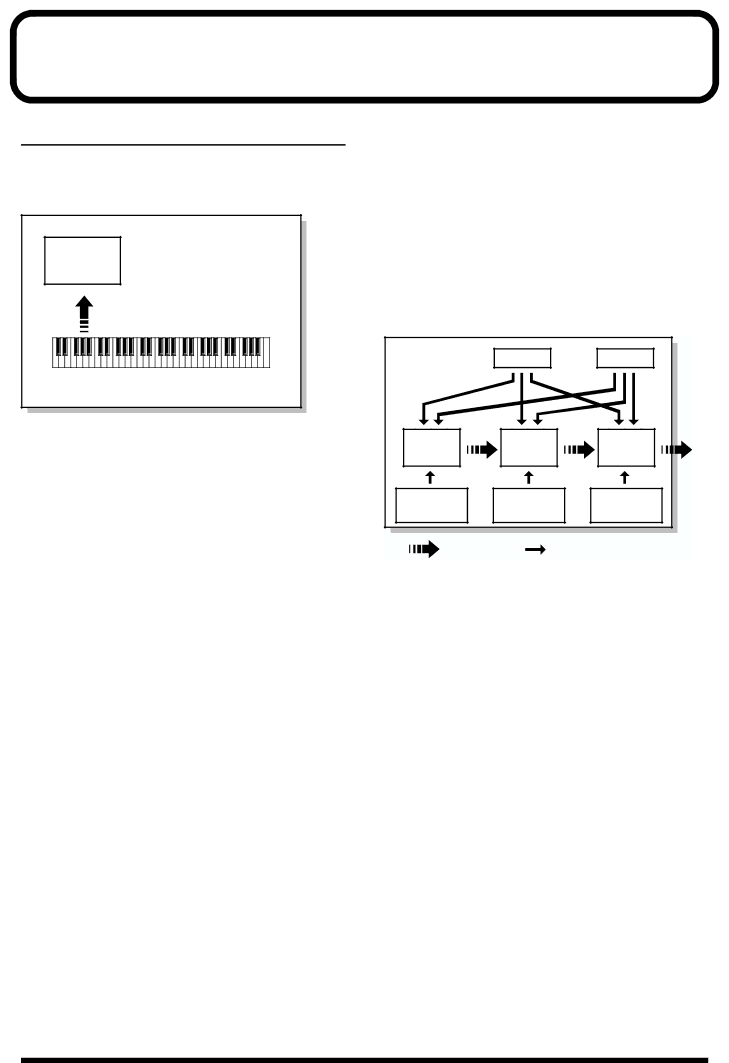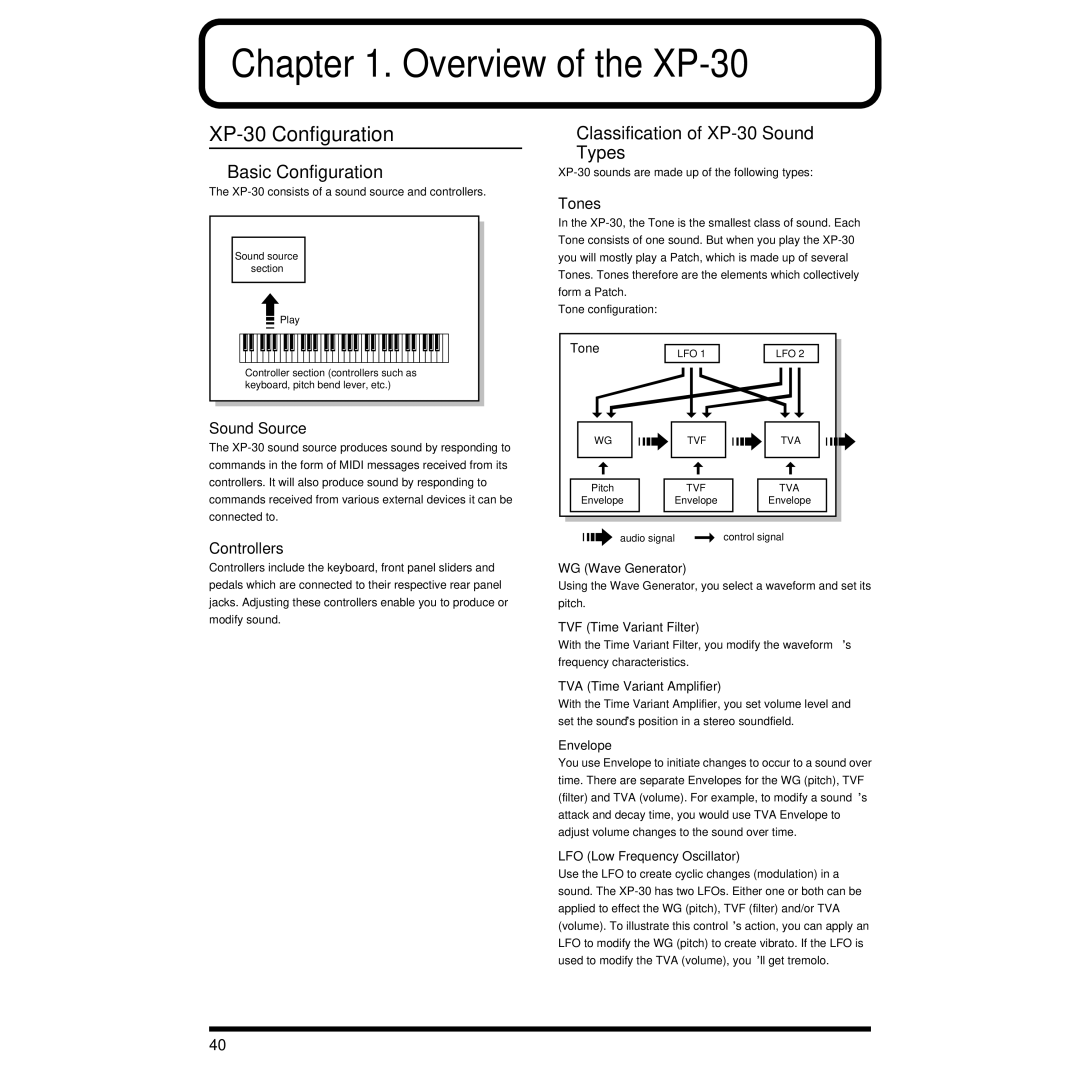Page
Important Safety Instructions
Page
Using the Unit Safely
Important Notes
Quick Start
Advanced Use
Appendices
Notation Used in This Owner’s Manual
Contents
Contents
Playing
Memory Settings Utility/Card Mode 115
Appendices 139
129
Main Features
Computer Interface Connector
High-Performance Synthesizer Sound Source
Expandability
Mode Section
Front and Rear Panel
Front Panel
Palette Section
Front and Rear Panel
Wave Expansion Section
Rear Panel
Quick Start
Installing the Wave Expansion Board
Getting Ready
Following diagram
Getting Ready
This completes installation of the Wave Expansion Board
Press EXP D or EXP E, and verify that you can select
Installation de la carte d’extension Wave
French language for Canadian Safety Standard
Éteindre le XP-30 et tous les appareils qui y sont reliés et
Rabranchez les câbles
Off the Power p et
Making Connections
Off for all devices
Connecting to Your Computer p
Turning On the Power
Before you turn the power on, check to make sure that
Reset to Default Factory Settings Factory Reset
Press Enter
Listening to the Demo Song
Demo Song Composer/Copyright
Profile of the Composer
Listening to the Demo Song
Playing the Sounds
Selecting Patches and Playing the Sounds
Selecting Wave Expansion Patches
Playing the Sounds
Press Category to make the indicator light
Selecting Patches by Category Patch Search Function
Press Category to make the indicator go dark
Auditioning the Patches Phrase Preview
Try Out Performance Functions
Velocity/Aftertouch
Hold Pedal
Play Arpeggios Arpeggiator
Sound Palette
Play a chord
Press Rhythm to make the indicator light
Play Percussion Sounds from the Keyboard
Chapter
XP-30 Configuration
Basic Configuration
Overview of the XP-30
Classification of XP-30 Sound Types
Patches
Performances
Overview of the XP-30 Rhythm Sets
Parts
Basic Operation
Switching Modes
Number of Simultaneous Voices
System Mode
Utility/Card Mode
GM Mode
About the Function Buttons
Overview of the XP-30 Patch Mode Edit Indicator is Dark
Rhythm Set Mode Edit Indicator is Dark
When Edit Indicator is Lit
About the Cursor Buttons
Modifying a Value
Using the Numeric Keys
Available characters/symbols
Assigning a Name
Convenient Functions
Playing in Patch Mode
Selecting a Patch Using Numeric Keys
Playing
Selecting a Patch
Selecting Patches by Category Patch Search Function
Express Patch Select Digit Hold
Using Phrase Preview to Play Patches
Mode Preview Sound Mode
Playing Single Notes Solo
Making a Patch Sound Thick or Thin Turning a Tone On/Off
Creating Smooth Pitch Changes Portamento
Playing in Performance Mode
Changing the Volume of Each Tone
Selecting a Performance Using Numeric Keys
Selecting a Performance
Playing Fatter and Richer Sounds by Combining Patches Layer
PERFORM/COMMON/PERFORM Common
Keyboard
Selecting a Part You Want to Play on
Muting a Specific Part Turning Receive Channel On/Off
Changing the Level Volume of Each Part
Assigning a Different Patch to a Part
Playing in Rhythm Set Mode
Selecting a Rhythm Set Using Numeric Keys
PR-A-C, E Preset A-C, E
Selecting a Rhythm Set
Playing an Arpeggio
Playing Percussion Instruments
Playing in Reggae Style
Playing an Arpeggio Over a Preset Keyboard Area
Playing Percussion Instruments
Using a Hold Pedal
Holding an Arpeggio
Simulating a Guitar Cutting Technique
Playing an Arpeggio from an External Midi Device
Convenient Functions for Performance
Transposing the Keyboard Octave Units Octave Shift
When Stuck Notes Occur
When a Note Does Not Sound
Transposing the Keyboard Semitone Steps Transpose
If Stuck Notes Occur or a
Regarding Effects
Creating Your Own Sounds
How Effects Units Work in Different Modes
Sound Editing Procedures
Turning Effects On/Off
Editing a Patch
Four Tips for Editing Patches
Editing Patches Using the Palette Display
Creating Your Own Sounds
Editing Performance Using the Palette Display
Editing a Performance
Editing a Rhythm Set
Keeping Edited Sound
Memory and Data Storage
Creating Your Own Sounds Rewritable Memory
Non-Rewritable Memory
Functions of Patch Parameters
Settings Common to the Entire Patch Common
Storing a Sound You Modify Into User Memory
Velocity Velocity Range
Creating Your Own Sounds KEY Rang Key Range
Struct Structure
Lower Key Range Lower
Upper Key Range Upper
Setting Effects for a Patch
Output
Patch EFX Type
Patch EFX PRM Patch EFX Parameters
Patch EFX Ctrl Patch EFX Control
Creating Your Own Sounds Patch EFX OUT Patch EFX Output
Patch Chorus
Using Controllers to Change How Sounds Are Played Control
KEY Mode & Bender
Key Assign Mode & Bender
Patch Reverb
Damper
RxSWITCH Receive Switch
Peak & Hold
Control Source
Control
Tone Delay
Modifying Waveform Wave
Wave
FXM Frequency cross modulation
Time Tone Delay Time
Modulating Sounds LFO
LFO1/LFO2
Modifying Pitch Pitch
LFO Depth
Pitch
PCH Envelope Pitch Envelope
PCH Time ENV Pitch Time Envelope
Modifying the Brightness Sound with a Filter TVF
Filter
Changing the Sound’s Volume Stereo Location TVA
TVF Velocity
TVF Envelope
TVF Time ENV TVF Time Envelope
Bias
PAN Modulate
TVA Time ENV TVA Time Envelope
TVA Envelope TVA Envelope
Settings Common to the Entire Performance Common
Functions of Performance Parameters
Perform Clock
Perform Common
Setting Effects for a Performance Effects
Perform EFX Type Performance EFX Type
Perform EFX PRM Performance EFX Parameters
Perform EFX OUT Performance EFX Output
Perform Reverb
Perform Chorus
Pitch Bend Pitch bend Aftertouch Aftertouch
Midi
Making Midi Settings for a Part Midi
Transmit Transmit Bank Select
Making Settings for Each Part Part
Setting
Confirming Midi Information for Each Part Info
Patch
Setting Effects for a Rhythm Tone
Functions of Rhythm Set Parameters
Naming a Rhythm Set Common
Rhythm Name Rhythm Set Name
Adjust the volume level of the chorus sound
Env Mode Envelope Mode
Switch Key Switch
Modifying Waveform of a Rhythm Tone Wave
Mute Group
Modifying Pitch of a Rhythm Tone Pitch
Changing the Tone Filter of a Rhythm Tone TVF
PCH Velocity
PCH Envelope
TVA Velocity
TVA Envelope
Multi-Effects Types EFX Parameter
STEREO-EQ Stereo Equalizer
Overdrive
Distortion
Spectrum
Phaser
Enhancer
AUTO-WAH
Rotary
HEXA-CHORUS
Compressor
Limiter
SPACE-D
TREMOLO-CHORUS
STEREO-CHORUS
STEREO-FLANGER
STEP-FLANGER
STEREO-DELAY
MODULATION-DELAY
TRIPLE-TAP-DELAY
100
Fbk Feedback Level
Level C Center Level Level L Left Level Level R Right Level
QUADRUPLE-TAP-DELAY
TIME-CONTROL-DELAY
Delay Delay time #
101
22 2VOICE-PITCH-SHIFTER
FBK-PITCH-SHIFTER
Feedback Pitch Shifter
102
Reverb
GATE-REVERB
OVERDRIVE→ Chorus
103
OVERDRIVE→ Delay
OVERDRIVE→ Flanger
DISTORTION→ Chorus
104
DISTORTION→ Delay
DISTORTION→ Flanger
ENHANCER→ Flanger
ENHANCER→ Chorus
ENHANCER→ Delay
CHORUS→ Delay
FLANGER→ Delay
106
CHORUS/DELAY
FLANGER/DELAY
CHORUS→ Flanger
CHORUS/FLANGER
Display Screen Contrast and Clock Settings Setup
Arpeggio Settings Arpeggio
System Setup
Arpeggio
109
Keyboard and Controllers Settings Control
Hold Pedal
Control Pedal
110
SYS-CTRL Assign System Control Assign
C1/C2/C3/C4 Assign C1/C2/C3/C4 Slider Assign
111
Midi Settings Midi
Patch Midi
GM Midi
Receive Midi
Phrase Preview Settings
Adjusting Tuning Tune
Battery Check
Program Change PGM Chng
Patch Scale KEY Scale
Transmit P.C
About Utility/Card Mode
Basic Procedure in Utility/ Card Mode
Util 1 Utility
Util 2 Utility
Storing Sound Data in User Memory Write
Performance Write
Patch Write
Rhythm Set Write
Settings Copy
Copying Sound Source
Performance Copy
Patch Copy
Rhythm Set Copy
Patch Name Copy
Rhythm Key Copy
Rhythm Set Name Copy
Initializing Sound Source Settings Init
Transmitting Sound Settings Xfer
Transmitting Data to User Memory
120
Type Data Type
Block Source Block
Settings Card
Before Using a Memory Card
Memory Card-Related
Preventing User Memory Writing Operation Protect
Loading a File from Memory Card into the XP-30 Load
Saving Data to Memory Card Save
Recalling Factory Default Settings Factory Reset
123
Entering GM Mode
Initializing the Sound Source For GM System Basic Settings
Playing Back a GM Score
Muting a Specific Part
Modifying GM Mode Settings
Making Effects Settings in GM Mode Effects
GM Chorus
GM Reverb
126
About Effects for GM-Compatible Sound Modules
Convenient Functions in GM Mode GM Utility
Setting a Part Part
Basic Procedure
Confirming Midi Information Each Part Info
Copying Effects Settings Copy
Initializing GM Mode Init
Transmitting GM Mode Settings Xfer
128
Techniques for Using Patches
Reinforcing Filter Characteristics
Holding a Note with Modulation Retained
Syncing the LFO Cycle to System Tempo
Modifying Multi-Effects to Match the System’s Tempo
Playing Phrase Loops at a System’s Tempo
130
Type EFX Parameter
Using the XP-30 to Play Live
Using the Slider to Pan Sounds Real Time
Changing Sounds with a Pedal Switch
131
Using External Midi Devices
Using the XP-30 to Control External Midi Devices
Selecting XP-30 Sounds from An External Midi Device
132
Getting the Full Potential of the XP-30 Selecting Patches
Selecting Performances
Selecting Rhythm Sets
133
Connecting to Your Computer
Connecting with Computer Connector
Enjoying Desktop Music
Two Connection Methods
Connecting with Midi Connectors
135
RSC-15APL
RSC-15AT
136
USB
Turn on the Thru Function of Your Sequencer Software
137
138
Appendices
139
Troubleshooting
Troubleshooting Sounds Are Interrupted
Specific Keyboard Area Does Not Sound
Sound Is Distorted
Pitch Is Incorrect
Error Messages
Patch Mode
Quick Reference of Procedures
Performance Mode
Controller Settings
Saving and Loading Data
Controlling External Midi Devices
Controlling the XP-30 from an External Midi Device
Other
Parameter List
Patch Parameters
Common Group p
Effects Group p
Parameter List Control Group p
Wave Group p
LFO Group p
148
Parameter List Pitch Group p
TVF Group p
TVA Group p
149
Performance Parameters
Parameter List
Midi Group p
150
Rhythm Set Parameters
Parameter List Part Group p
Information Group p
151
152
NO-SUS, Sustain
PCH Velocity
TVA Velocity
GM Mode Parameters
153
EFX Parameters
Parameter List STEREO-DELAY p
MODULATION-DELAY p
TRIPLE-TAP-DELAY p
TREMOLO-CHORUS p
Parameter List QUADRUPLE-TAP-DELAY p
TIME-CONTROL-DELAY p
OVERDRIVE→ Delay p
22 2 VOICE-PITCH-SHIFTER p
DISTORTION→ Delay p
ENHANSER→ Delay p
CHORUS→ Delay p
Parameter List FLANGER→ Delay p
Setup Group p
System Parameters
Arpeggio Group p
158
Parameter List Midi Group p
Preview Group p
Tune Group p
PGM Chng Group p
Waveform List
INT-A Internal a
160
Name
161
Waveform List INT-B Internal B
MMM VOX
162
Waveform List XP-A Wave Expansion a Session
FX Menu
Waveform List XP-A Menu Waveforms
163
Waveform List XP-B Wave Expansion B Orchestral
164
REV SNR
REV BD
Waveform List XP-C Wave Expansion C Techno Collection
165
Waveform List XP-C Menu Waveforms
166
Waveform List
167
User User Group PR-A Preset a Group
Patch List
168
No. Name Voice Key Assign
Patch List
PR-B Preset B Group PR-C Preset C Group
169
Patch List PR-D GM Group PR-E Preset E Group
170
Poly *1
Poly *2
171
Patch List XP-A Wave Expansion a Session
Name Voice
Patch List XP-B Wave Expansion B Orchestral
172
Patch List XP-C Wave Expansion C Techno Collection
173
How to Read the Table
M. Conversion When Creating Patches
M. Conversion When Creating Rhythm Sets
174
175
Original B.P.M 120 132 138
120
132
176
Original B.P.M 144 160 184
144
160
Rhythm Set List
User User PR-A Preset a Group PR-B Preset B Group
177
Rhythm Set List
PR-C Preset C Group PR-D GM Group PR-E Preset E Group
178
XP-A Wave Expansion a Session
179
001 002 003 004 005 006 007 008 SessionSet Demo Drum
180
XP-C Wave Expansion C Techno Collection
PHH Menu TR606 PHH
OHH Menu CR78 OHH
User User Group PR-A Preset a Group PR-B Preset B Group
Name Key Mode
Performance List
181
182
Arpeggio Style List
Style Motif Beat Pattern Accent Rate
Midi Implementation
183
Polyphonic Aftertouch
Control Change
Midi Implementation
184
185
186
Universal Realtime System Exclusive messages
187
Data Transmission
Midi Implementation Data transmission sound source section
188
189
RPN MSB/LSB Controller number 100,101
Identity Reply Message
Data Set1
Midi Implementation Parameter Address Map
190
System
System Common
191
Scale Tune
Performance
192
Performance Common
193
Performance Part
Patch
Patch Common
194
Patch Tone
195
OFF, CONTINUOUS, KEY-ON
Rhythm Setup
196
Rhythm Common
Rhythm Note
197
NO-SUS, Sustain OFF, CONTINUOUS, KEY-ON
198
GS Model ID = 42H
199
200
201
202
Arpeggio Style
Arpeggio Motif
Arpeggio Beat Pattern
203
Examples of Actual Midi Messages
204
Examples of Exclusive Messages Calculating the Checksum
205
Equal Temperament
Just Intonation tonic of C
Arabian-type Scale
Nrpn LSB, MSB
206
RPN LSB, MSB
Specifications
Computer Cable Wiring Diagrams
208
Index
209
Index
210
211
Level
212
Perform
213
Solo
214
UTIL/CARD
Avis
Information
Africa

